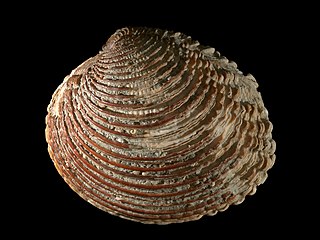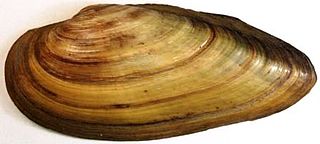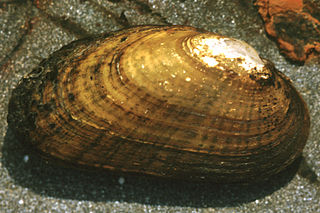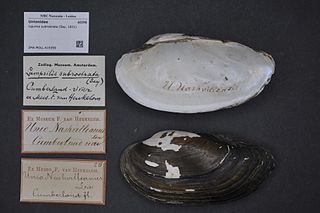
The Veneridae or venerids, common name: Venus clams, are a very large family of minute to large, saltwater clams, marine bivalve molluscs. Over 500 living species of venerid bivalves are known, most of which are edible, and many of which are exploited as food sources.

The Unionidae are a family of freshwater mussels, the largest in the order Unionida, the bivalve molluscs sometimes known as river mussels, or simply as unionids.

Unio crassus, the thick shelled river mussel, is a species of freshwater mussel, an aquatic bivalve mollusk in the family Unionidae, the river mussels.

Unio is a genus of medium-sized freshwater mussels, aquatic bivalve mollusks in the family Unionidae, the river mussels. They are found throughout Europe, Africa, and the Middle East, with some species introduced to East Asia. Fossil species are also known from the Jurassic of North America.
Alasmidonta atropurpurea, common name Cumberland elktoe, is a species of freshwater mussel, an aquatic bivalve mollusk in the family Unionidae, the river mussels.

Unionida is a monophyletic order of freshwater mussels, aquatic bivalve molluscs. The order includes most of the larger freshwater mussels, including the freshwater pearl mussels. The most common families are the Unionidae and the Margaritiferidae. All have in common a larval stage that is temporarily parasitic on fish, nacreous shells, high in organic matter, that may crack upon drying out, and siphons too short to permit the animal to live deeply buried in sediment.

Lampsilis bracteata, also known as the Texas fatmucket, is a species of freshwater mussel in the family Unionidae, the river mussels. This species is endemic to the tributaries of the Colorado River within the Edwards Plateau region in Texas, the United States. Populations from the upper Guadalupe River basin are now assigned to a distinct species, Lampsilis bergmanni. The two species are morphologically indistinguishable but genetically distinct.

Ptychobranchus subtentum, also known as the fluted kidneyshell, is a species of freshwater mussel, an aquatic bivalve mollusk in the family Unionidae, the river mussels.
Unio cariei was a species of medium-sized freshwater mussel, an aquatic bivalve mollusc in the family Unionidae.
Unio turtoni is a species of medium-sized freshwater mussel, an aquatic bivalve mollusk in the family Unionidae, the river mussels.

Charles Torrey Simpson was an American botanist, malacologist, and conservationist. He retired to Florida where he became known for conservation.

Villosa iris, the rainbow mussel or rainbow-shell, is a species of freshwater mussel, an aquatic bivalve mollusk in the family Unionidae, the river mussels. In 2018, Watters proposed to move the species into a new genus, Cambarunio.
Bryant Walker (1856–1936) was an American malacologist who specialized in the non-marine Mollusca. He mainly studied the freshwater mollusks of the USA, in particular those of Michigan. He published many papers on the Unionida, an order of freshwater mussels.

Sagittunio subrostratus, commonly referred to as the pondmussel or black pondmussel, is a species of freshwater mussel, an aquatic bivalve in the family Unionidae, the river mussels.

Unio mancus is a species of freshwater mussel, an aquatic bivalve mollusk in the family Unionidae, the river mussels.

Potomida littoralis is a species of bivalve belonging to the family Unionidae.

Unio tumidiformis is a species of bivalve belonging to the family Unionidae. It is endemic to the southwestern Iberian Peninsula. Existing populations are known from the Guadiana, Mira, and Sado Rivers in Portugal and Spain.













